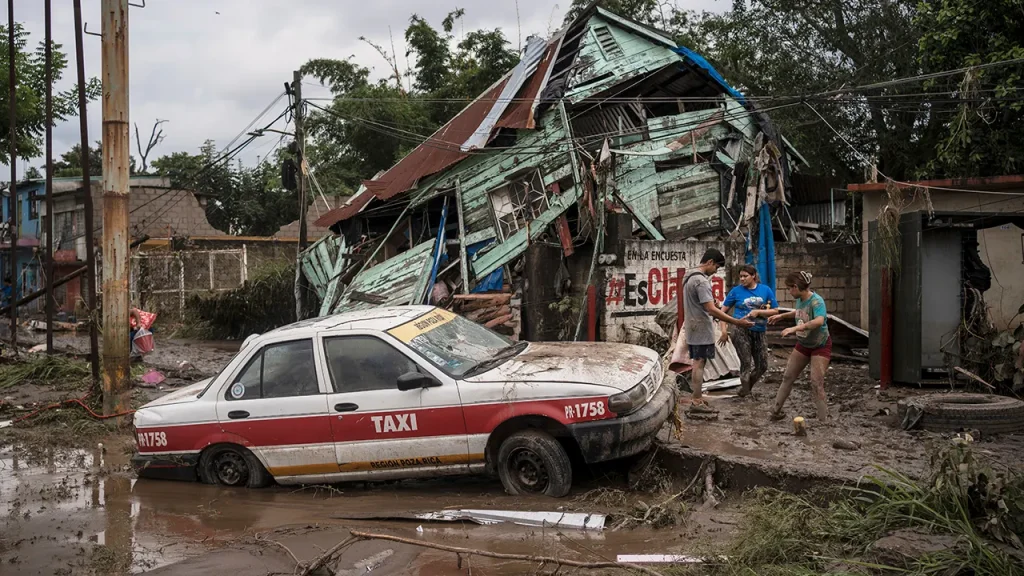Mexico’s Devastating Floods Leave Over 40 Dead and Thousands Homeless
In a heart-wrenching tragedy that has unfolded across central and southeastern Mexico, at least 41 people have lost their lives as relentless torrential rainfall triggered catastrophic floods and landslides. The devastation has been most severe in the states of Hidalgo, Puebla, and Veracruz, where thousands of soldiers are now engaged in rescue operations, navigating through destruction of unimaginable proportions. As waters recede, they reveal the grim aftermath: roads blocked by uprooted trees and mangled cars, communities cut off from essential services, and families desperately searching for missing loved ones. The human toll of this disaster extends far beyond numbers, with each victim representing a profound personal tragedy and each survivor facing the daunting task of rebuilding their lives from the sodden ruins of what once was home.
In the oil town of Poza Rica, located about 170 miles northeast of Mexico City, residents described the terrifying moment when disaster struck. They recounted hearing the ominous roar of an approaching wall of water, followed by the sickening crash of vehicles colliding before floodwaters more than 12 feet high engulfed their streets on Friday. For many, the warning came too late. Twenty-seven-year-old Shadack Azuara shared his heartbreaking story of visiting his uncle’s home early Friday morning before the floods hit. When no one answered his knock, he assumed his uncle had evacuated with others. Returning the next day, Azuara made the devastating discovery of his uncle’s body, facedown in the murky water that surrounded his bed—a tragic reminder that not everyone had the chance or means to escape the rapidly rising waters.
The state of Hidalgo, north of Mexico City, has suffered particularly severe losses, with authorities confirming at least 16 deaths. Beyond the human tragedy, the infrastructure damage has been extensive, with power outages affecting 150 communities and leaving countless families without electricity during this crisis. The darkness only compounds the challenges facing both survivors and rescue workers as they navigate treacherous conditions. Meanwhile, in Puebla, east of Mexico City, at least nine people have perished in the flooding, and the material destruction is staggering—over 16,000 homes have been damaged or completely destroyed. For the families affected, these aren’t just buildings but the repositories of memories, hard-earned possessions, and the security of having a place to call home—all washed away in hours of relentless rainfall.
Veracruz state has reported 15 fatalities, with the army and navy mobilizing for extensive rescue operations across dozens of isolated communities. Landslides and swollen streams have blocked crucial roadways, effectively cutting off entire villages and hampering relief efforts. The search continues for 27 people reported missing across the region, with each passing hour diminishing hopes for their survival. The scale of destruction in Veracruz alone is staggering, with 16,000 homes damaged across 55 municipalities. In Querétaro, a central Mexican state, the disaster claimed its youngest victim when a child perished in a landslide, underscoring the indiscriminate nature of such natural catastrophes and the vulnerability of the most innocent among us.
The current crisis in Mexico echoes similar climate-related disasters that have struck the Americas in recent years, including Hurricane Helene’s devastating impact on North Carolina just one year ago. These recurring catastrophes highlight the increasing frequency and severity of extreme weather events that many scientists attribute to climate change. For the communities affected in Mexico, however, such global perspectives offer little immediate comfort as they face the urgent tasks of recovering bodies, locating the missing, and beginning to rebuild shattered infrastructure and lives. The floodwaters may eventually recede, but the trauma inflicted on these communities will remain, becoming part of their collective memory and shaping their approach to future rainy seasons.
As rescue operations continue and the full extent of the damage becomes clearer, the affected Mexican states face enormous challenges in recovery and rebuilding. Beyond the immediate humanitarian response, questions will inevitably arise about early warning systems, evacuation protocols, and infrastructure resilience. For now, though, the focus remains on the human dimension of this tragedy—finding the missing, supporting survivors, and honoring those who lost their lives. In towns like Poza Rica, residents who lived through the terrifying wall of water must now face another daunting prospect: rebuilding homes and livelihoods from scratch, carrying forward the memory of neighbors and family members who didn’t survive, and somehow finding the resilience to prepare for an uncertain future where such extreme weather events may become increasingly common.


